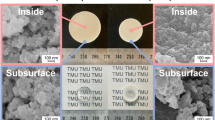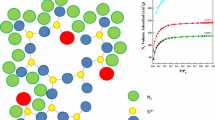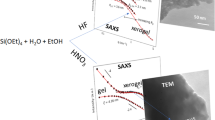Abstract
ORMOSILs have been prepared in the series TMOSx·MTMS(100 − x) (where TMOS is tetramethoxysilane; MTMS is methyltrimethoxysilane; x is mol% silane with respect to total silane for 0 ≤ x ≤ 100) by means of acid catalyzed, sol-gel processing. After drying at 60°C, small bulk samples were obtained of excellent optical clarity. Powder X-ray diffraction (XRD) patterns, in the range of 5 to 60°2Θ, were compared with that of fused silica. All the prepared samples were amorphous. Fused silica exhibits one broad peak, d2 centered at d-spacing 4.12 Å. For the TMOS100 silica xerogel, the analogous broad peak had shifted slightly, to be centered at 3.88 Å; and remained in about the same position as x was decreased for the series TMOSx·MTMS(100 − x). In addition, a second, broad peak, d1, was observed for the ORMOSIL series centered at the d-spacing 8.7 Å for MTMS100 (i.e., x = 0) and increasing smoothly as x was increased, reaching 11.3 Å for x = 70, and >11.3 Å for x > 70. The intensity of d1 was found to have trebled, relative to the intensity of d2, on increasing the organic character of the matrix from TMOS70·MTMS30 to MTMS100.
The d2 peak appearing at about 4 Å for both fused silica and the ORMOSILs is assumed to be associated with the spacing between silicon atoms connected by means of an oxygen bridge. The Si–O–Si angle for silica xerogels is known to depend upon the nature of the sol-gel processing and is bigger than that of fused silica.
The d1 peak may be associated with the spacing between silicons attached to methyl groups and indicative of channels of methyl groups in the structure. Alternatively, the d1 peak may have its origin in a preferred, discrete structural unit in the matrix for instance cubane based on a octameric silicon arrangement.
Similar content being viewed by others
References
S.L.B. Lana, Ph.D. Thesis, Department of Engineering Materials, University of Sheffield, 1994, p. 146.
W.D. Kingery, H.K. Bowen, B.R. Uhlman, Introduction to Ceramics (John Wiley & Sons, NY, 1976), p. 91.
J.R. Fitzpatrick and B. Ellis, The Physics of Glassy Polymers (Applied Science Publishers Ltd., London, 1973), p. 108.
J. Bockrins, The Vitreous State (The Glass Delegacy of the University of Sheffield, 1955), p. 61.
C.E. Magrabi, Ph.D. Thesis, Department of Ceramics, Glasses and Polymers, University of Sheffield, 1970, p. 54.
C.J. Brinker and G.W. Scherer, Sol-Gel Science: The Physics and Chemistry of Sol-Gel Processing (Academic Press, NY, 1990), pp. 241, 577, 583.
Author information
Authors and Affiliations
Rights and permissions
About this article
Cite this article
Lana, S., Seddon, A. X-Ray Diffraction Studies of Sol-Gel Derived ORMOSILs Based on Combinations of Tetramethoxysilane and Trimethoxysilane. Journal of Sol-Gel Science and Technology 13, 461–466 (1998). https://doi.org/10.1023/A:1008685614559
Issue Date:
DOI: https://doi.org/10.1023/A:1008685614559




